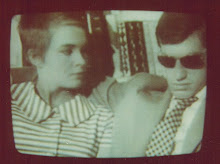 Documentary filmmaker, Michael Almereyda, captured the photographer who gained notoriety in 1976 when he was just thirty-seven and his photographs were included in MOMAs first show of color photography.
Documentary filmmaker, Michael Almereyda, captured the photographer who gained notoriety in 1976 when he was just thirty-seven and his photographs were included in MOMAs first show of color photography.He had already completed his ambitious 1974 Los Alamos Project, a collection of more than two thousand photos--ordinary shots of cars, women and objects in brilliant color infused with his dye transfer process. Influenced by Walker Evans, Lee Friedlander, Robert Frank, Eggleston's images at first glance are not too different from those in family photo albums. At second glance, they are spectacular, given the era and equipment that he used. He approached the work as if a fragment can reflect the greater whole. He was inspired by the writings of Cartier-Bresson in The Decisive Moment. Some say his stills resemble those of filmmaker David Lynch. He was finally able to showcase more of those shots in a show at The J. Paul Getty Museum during 2000.
John Szarkowski's essay of Eggleston's work remains one of the more definative commentaries on the photographer. The essay points out that "the world now contains more photographs than bricks." Eggleston made photos featuring the richness of the visible world where everything is worth looking at and photographing. Haunting and hopeful, this society is decaying and becoming, a democracy of objects showing the nature of perception. This was all before digital imagery flooded our world.
His grandfather, a judge, was an amatuer photographer who invited Eggleston to play in his darkroom and gave him a Brownie camera for his tenth birthday. The film suggests that the sudden death of this paternal figure sparked young Eggleston's compulsion to create throughout his life in and around Memphis. He began filming his family as a teen and made some videos during the early 1970s featuring his bohemian crowd--intense, dismal, wreckless--socializing, discussing, drunk and drugged. Though, these films were engaging, Eggleston dropped the video camera and focused on his still photography.
We see Bill drawing his mistress, Lucia Birch, as she made odd drunken comments throughout. A heavy drinker and constant smoker who had bouts of depression, he also had the support of his wife and children to fulfill a career of work that won him Getty Images' Lifetime Achievement Award. He said little upon receiving this, but commented about art...
"You love and appreciate it, but you cannot really talk about it."
After this film was released, the artist was given a retrospective show at The Whitney Museum in 2008.





No comments:
Post a Comment